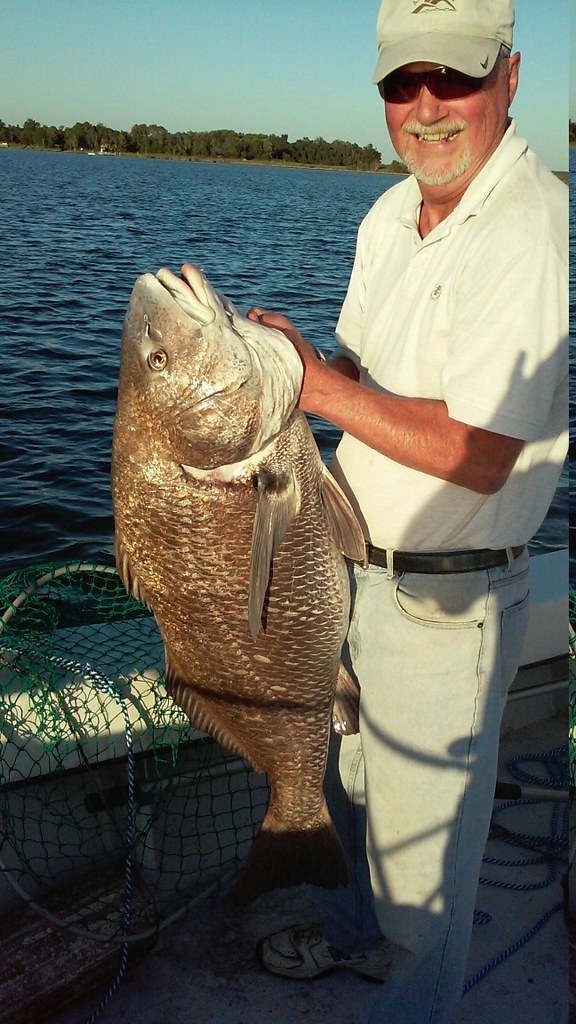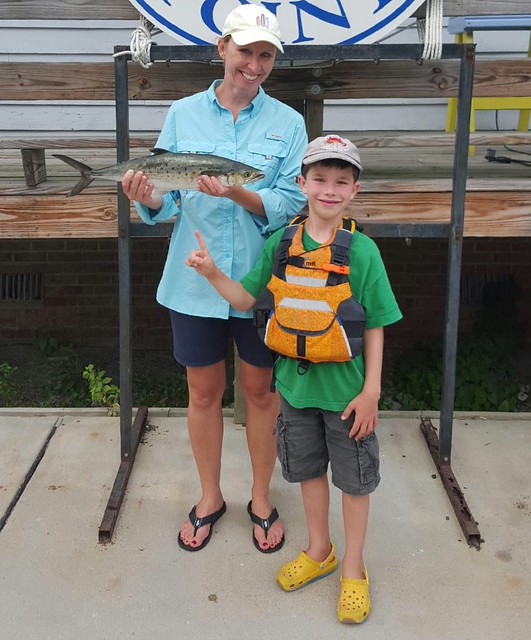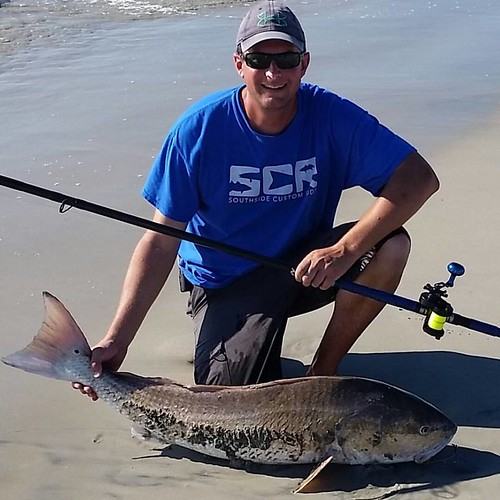By: Keith Lockwood
The summer doldrums are over and weather patterns are changing. As we transition into fall and cooler temperatures there is bound to be some turmoil on the weather front. It has been tough to get out on the more open waters for the past week and now it looks like we have a tropical storm moving up the coast. Hang on to your hat and keep a watch on the weather.
It has been very difficult for most to get out on the open water of the upper bay or its tidal rivers for the past 5 or 6 days due to strong northeast winds. Over the weekend a few tried to find a lee against a protected shore and some were out rolling in the chop trolling. Fortunately the windy weather has passed for now but we paid the price with heavy rain and the possibility of more rain and wind in the forecast. There are plenty of striped bass and small bluefish in the upper bay this week and they can be found primarily along channel edges where swift currents are balling up schools of bay anchovies. When this occurs on the surface diving sea gulls will usually lead the way to some exciting action. As long as bluefish are around most will be using metal and make sure to use black swivels if using a leader. Sub surface action can often be detected by slicks and a depth finder will confirm the action deep below the surface. Small spoons and surge tube lures have been two of the favorite offering in a trolling spread when pulled behind inline weights and planers. The edges at Love Point, the Triple Buoys, the Dumping Grounds and Podickory Point have been good places to start the search for fish. Jim Trumbauer was trolling a small bucktail and twister tail combo in the lower Chester River for striped bass when he hooked into this black drum which he landed and then released.

Photo courtesy Jim Trumbauer
The water temperatures in the upper bay have dropped to about 73° at the mouth of the Susquehanna River to about 71° off Baltimore. Just a few more degrees lower and striped bass should begin to move into the lower sections of the tidal rivers with more earnest to intercept schools of baitfish moving out of the rivers. Two fun methods to take advantage of this scenario are light tackle jigging or using topwater lures around surface feeding fish. At the moment most are reporting that the striped bass in the tidal rivers of the upper bay tend to be in the 14" size range. There are some larger fish being caught though especially by those live lining spot or eels near Pooles Island and the Key Bridge and Bay Bridge piers.
The middle bay region continues to offer good trolling opportunities for a mix of Spanish mackerel, striped bass and small bluefish. Most are pulling a mixed spread of small Clark or Drone spoons and surge tube lures behind planers and inline weights along channel edges. There is good trolling along the western side of the shipping channel from Breezy Point to the Bay Bridge and the Gum Thickets to the CR Buoy edge on the eastern side of the shipping channel. Schools of bay anchovies are being swept along by tidal currents and often tend to concentrate where the currents are strongest. Diving sea gulls will mark the presence of surface action where casting topwater lures or jigs can offer a lot of exciting fun. Watching for gulls sitting on the water or slicks can also lead the way to finding action below the surface.
There is still good live lining action to be found at the Hill, the Bay Bridge piers and steep channel edges in the region. The impending rough weather which is forecasted to head our way may send the last of the spot in the middle bay scurrying south and and may also put a damper on fishing. Live lining eels is becoming more popular as October approaches and is often a good ticket for a larger grade of striped bass.
Water temperatures in the middle bay region are about 70° and continue to fall as cooler nights become more common. The salinity has been around 16 P.P.T. in most areas and if we get hit with a tropical storm that seems to be making its way up the coast we will see some changes. The Spanish mackerel will most likely head south and a lot of the bluefish with them along with what spot are left. The striped bass action should kick into a higher gear with light tackle jigging being the most popular way to fish.
White perch fishing has been good in many areas where there is good bottom structure such as deep water piers, rocks and bridge piers. Prominent points with deep water and hard bottomed shoal areas in the lower sections of the regions tidal rivers have been good places to fish with small jigs and bottom rigs baited with bloodworms.
At present the lower bay region has some outstanding fishing for large spot in the lower Patuxent and Potomac Rivers. Locals have been taking advantage of the good fishing and stocking up on some good eating. A simple bottom rig baited with pieces of bloodworm is all one needs. White perch are also being caught in many of the same areas but the croaker seem to have left for parts south.
Bluefish tend to be spread throughout the lower bay region and they are mixed in with Spanish mackerel in many areas. Trolling has been a popular way to get in on the action with Clark and Drone spoons behind inline weights and planers. Surge tube lures will also work well for the bluefish. Breaking fish are being spotted throughout the region and usually are a mix of Spanish mackerel and bluefish and at times striped bass may join in or hang underneath the surface action. Most of the baitfish in the area are bay anchovies and they often are being swept along by tidal currents near channel edges or being pushed to the surface by rockfish and blues. Travis Long has a right to be proud of his Maryland Fishing Challenge award size Spanish mackerel as he gets a little help from his mom.

Photo courtesy Travis Long
There has been some striped bass action in the lower Potomac and Patuxent Rivers where they are being found suspended along steep channel edges. There is some early morning and late evening shallow water action near Cedar Point and along shoreline structure for those casting topwater lures and sassy shads. There are also large red drum still in the region and they are being caught by trolling large spoons or by jigging with soft plastics or metal.
Recreational crabbing continues in high gear for those still heading out with trot lines and collapsible traps. A further drop in water temperatures will tend to drive crabs deeper and if we receive heavy rains later on this week this could drive crabs from the upper river areas. We are at the doorstep of October so if crab cakes on a winter night are in your dreams, you best make haste.
This is a wonderful time of the year for fishing in the western region of Maryland; the waters are cooling causing fish to be more active, the leaves are starting to show a little color and places like Deep Creek Lake have lost most of their water traffic. At Deep Creek Lake fishing for a mix of smallmouth bass and largemouth bass has been good near the remaining floating docks, fallen tree tops and rocky points. Most are casting a variety of baits such as jerkbaits, crankbaits, tubes and spinnerbaits with good success. Topwater lures are very effective in the early morning hours. There are northern pike near the mouths of coves and chain pickerel and largemouth bass back in the grassy areas of the coves.
The upper Potomac continues to run very low and clear at the moment but these conditions could change drastically if the predicted heavy rains hit the watershed towards the end of the week. Tubes have been the first choice for many fishing the upper Potomac for smallmouth bass but crankbaits can also be a good choice.
The trout management waters of western Maryland are usually some of the first to receive trout stockings because of cool water conditions. Weather and stream conditions will be major factors in the fall stocking schedule and for this reason typically the stockings are posted as they occur. Checking the trout stocking website or being on the email subscription list are the best ways to stay informed. Amanda Murphy was fishing on the North Branch of the Potomac when she caught this beautiful rainbow trout recently.

Photo courtesy Amanda Murphy
Cooler water temperatures have most freshwater fish in a very active feeding mode as they feel the need to fatten up for the long winter months ahead. Largemouth bass are feeding aggressively in a variety of cover types from shallow grass cover areas to deeper sunken structure locations. Topwater lures are always an exciting way to fish the shallow areas such as grass and lily pad fields. Spinnerbaits and crankbaits are good choices around the edges of these areas and grubs and deep running crankbaits are good choices for deeper cover. Plastic worms and stick worms are effective around thick cover such as grass or sunken wood depending on how they are rigged.
Crappie are beginning to feel the urge to school up in deeper waters and can be caught on minnows or small jigs under a bobber near structure. Fishing for channel catfish remains good in many of the bays tidal rivers and there are always plenty of blue catfish in the tidal Potomac.
There has been some smallmouth bass action on the lower Susquehanna River lately and there continues to be good largemouth bass fishing on the Susquehanna Flats in the mornings and evenings with topwater lures. Flathead catfish can also be found in the lower Susquehanna, with the largest ones being found in the Conowingo Dam hole and smaller ones farther down the river.
The Ocean City area has been buffeted by northeast winds for quite a while now and it would appear that we're in for some more plus heavy rain. Cooler nights are dropping water temperatures and flounder are moving into the channels that lead towards the Ocean City Inlet. Some are already slipping through the inlet headed for offshore waters. The inlet and the Route 50 Bridge areas will be good areas to target if the water clarity holds up. Tautog are moving into the inlet and taking up residence along bridge piers, rocks and bulkheads. Sand fleas and pieces of green crabs are the baits of choice. There have been some large bluefish moving in and out of the inlet recently making for some fun fishing.
It has been tough for anyone to go surf fishing for the past week along the beaches. Heavy surf and grass have been making for difficult if not impossible fishing conditions. The kingfish should still be here, the fall migration of large red drum may have slipped by in all the turmoil but striped bass will start to become a more common occurrence. Andrew Kumjian managed to make a date with this large red drum as it was passing along the Assateague beaches and got a nice picture before releasing it. Andrew also has registered his 46.5" red drum in the Maryland Fishing Challenge.

Photo courtesy Andrew Kumjian
Flounder are still in residence on the inshore shoal areas and the wreck and reef sites and will be waiting when the ocean waters calm down. Offshore it is much the same story; the ocean needs to lay down some before anyone can think about making a run out to the canyons. After a blow like this it is not uncommon to see profound changes in the fishery in regards to yellowfin tuna, bigeye tuna and white marlin. The longfin albacore tend to make a brief appearance this time of the year and bluefin tuna will be passing by soon.
Boom...Morgan
No comments:
Post a Comment